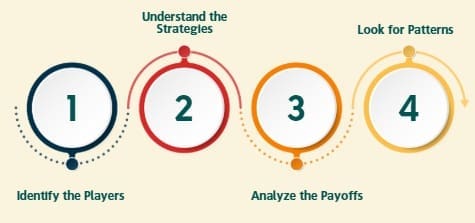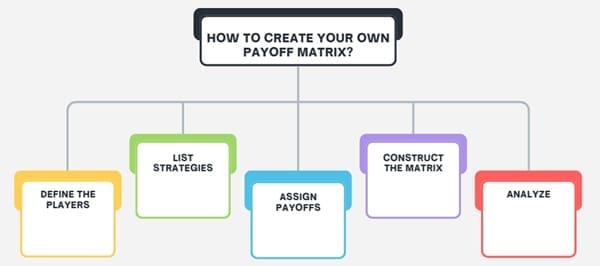A payoff matrix is a table that describes all possible outcomes when multiple decision-makers interact strategically. Think of it as a crystal ball that shows you every potential result based on the choices available to you and your competitors. This powerful tool represents the heart of normal form game theory, providing a visual snapshot of complex strategic situations.
The beauty of understanding what is payoff matrix lies in its simplicity. Each cell in this strategic matrix contains numbers representing the rewards or penalties—the “payoffs”—that each player receives based on their combined choices. By organizing these outcomes systematically, the game matrix transforms abstract strategic thinking into concrete analysis.
Table of contents
What is a Payoff Matrix?
A payoff matrix, often referred to as a game matrix or payoff table, is a powerful tool in game theory that visualizes the outcomes of strategic interactions between players. In essence, it’s a table that describes the rewards or consequences (payoffs) each player receives based on their chosen strategies.
Think of it as a roadmap for decision-making, where every route leads to a unique destination—some favorable, others less so.
In a normal form game, the payoff matrix organizes the strategies of two or more players in a structured format, typically a grid. Each cell in the matrix represents a possible outcome, showing the payoffs for all players based on their combined choices. This setup allows analysts to predict how rational players might behave in competitive or cooperative scenarios.
For example, in a business context, two companies might use a payoff matrix to evaluate whether to lower prices or maintain them. The matrix reveals the potential profits (or losses) for each company based on their pricing strategies. By laying out all possible outcomes, the payoff matrix becomes an indispensable tool for strategic planning.
How to Read a Payoff Matrix?

Reading a payoff matrix might seem daunting at first, but it’s surprisingly straightforward once you break it down. Let’s walk through the process step-by-step to demystify this strategic matrix.
Step 1: Identify the Players
Every payoff matrix involves at least two players, such as businesses, individuals, or even countries. These players are typically listed along the rows and columns of the matrix. For instance, in a two-player game, Player A’s strategies might be listed along the rows, while Player B’s strategies are along the columns.
Step 2: Understand the Strategies
Each player has a set of possible actions or strategies. These could be as simple as “cooperate” or “compete” or as complex as specific pricing levels in a market. The strategies form the framework of the matrix, defining the choices available to each player.
Step 3: Analyze the Payoffs
Each cell in the matrix contains a pair (or more, for multi-player games) of numbers representing the payoffs for each player. For example, in a two-player game, a cell might show (3, 2), where 3 is Player A’s payoff and 2 is Player B’s. These numbers could represent profits, utility, or any measurable outcome.
Step 4: Look for Patterns
Once you understand the structure, you can analyze the matrix for patterns like a dominant strategy—a choice that’s always best for a player, regardless of what others do. Alternatively, you might identify a Nash equilibrium, where no player can improve their payoff by changing their strategy unilaterally.
Public, Onsite, Virtual, and Online Six Sigma Certification Training!
- We are accredited by the IASSC.
- Live Public Training at 52 Sites.
- Live Virtual Training.
- Onsite Training (at your organization).
- Interactive Online (self-paced) training,
Examples
To bring the concept to life, let’s explore a few payoff matrix examples that illustrate its practical applications.
Example 1: The Prisoner’s Dilemma
The Prisoner’s Dilemma is a classic normal form game in game theory. Imagine two suspects, Alice and Bob, arrested for a crime. They can either confess or remain silent. The payoff matrix might look like this:
| Alice \ Bob | Confess | Silent |
| Confess | (-5, -5) | (0, -10) |
| Silent | (-10, 0) | (-1, -1) |
- If both confess, they each get 5 years in prison (-5, -5).
- If one confesses and the other stays silent, the confessor goes free (0), while the silent one gets 10 years (-10).
- If both stay silent, they each get 1 year (-1, -1).
This matrix reveals a dominant strategy: confessing is better for each player, regardless of the other’s choice. However, the best collective outcome (-1, -1) occurs when both stay silent, highlighting the tension between individual and group interests.
Example 2: Business Pricing War
Consider two competing coffee shops, Brew A and Brew B, deciding whether to lower or maintain their prices. The payoff matrix economics might look like this:
| Brew A \ B | Lower Price | Maintain Price |
| Lower | (50, 50) | (80, 20) |
| Maintain | (20, 80) | (70, 70) |
- If both lower prices, they split the market but earn less profit (50, 50).
- If one lowers and the other maintains, the lower-priced shop gains more customers (80, 20).
- If both maintain prices, they share higher profits (70, 70).
This matrix helps businesses predict competitor behavior and strategize accordingly.
Role of Payoff Matrices in Economics and Beyond
Payoff matrices aren’t just theoretical tools—they have real-world applications across various fields. In economics, they help analyze market competition, trade negotiations, and resource allocation. For instance, a payoff matrix economics approach can model how firms decide on production levels in an oligopoly, like OPEC’s oil output decisions.
Beyond economics, payoff matrices are used in:
- Business Strategy: Companies use them to anticipate competitor moves, such as in pricing, marketing, or product launches.
- Political Science: Governments analyze payoff matrices to navigate international relations, like trade agreements or military strategies.
- Environmental Studies: Researchers model cooperation in climate change agreements, where countries decide whether to reduce emissions.
By providing a clear framework for decision-making, payoff matrices empower professionals to make informed choices in complex, competitive environments.
Also Read: How to Make a Requirements Traceability Matrix (RTM)?
Dominant Strategies and Nash Equilibrium
To deepen your understanding, let’s explore two critical concepts in game theory payoff matrix analysis: dominant strategies and Nash equilibrium.
Dominant Strategy
A dominant strategy is a choice that yields the best payoff for a player, no matter what the other players do. In the Prisoner’s Dilemma, confessing is a dominant strategy because it minimizes jail time for each suspect, regardless of the other’s decision. However, not all games have dominant strategies, making analysis more complex.
Nash Equilibrium
Named after mathematician John Nash, a Nash equilibrium occurs when no player can improve their payoff by unilaterally changing their strategy. In the coffee shop example, both shops lowering prices (50, 50) might be a Nash equilibrium if neither can gain by switching to maintaining prices alone. Identifying this equilibrium helps predict stable outcomes in strategic interactions.
How to Create Your Own Payoff Matrix?

Ready to build your own payoff matrix template? Follow these steps:
- Define the Players: Identify the decision-makers (e.g., two companies, individuals, or teams).
- List Strategies: Determine the possible actions each player can take.
- Assign Payoffs: Estimate the outcomes (e.g., profits, costs, or utility) for each combination of strategies.
- Construct the Matrix: Organize the strategies and payoffs into a table, with rows for one player and columns for the other.
- Analyze: Look for dominant strategies, Nash equilibria, or other patterns to guide decision-making.
For example, a priority payoff matrix could help a project manager decide which tasks to prioritize based on time and resource constraints, with payoffs reflecting project success metrics.
Common Misconceptions About Payoff Matrices
Despite their utility, payoff matrices can be misunderstood. Here are some common myths debunked:
- Myth 1: Payoff Matrices Are Only for Two Players
While two-player matrices are common, they can be extended to multiple players, though the complexity increases. - Myth 2: Payoffs Are Always Monetary
Payoffs can represent any measurable outcome, from happiness in social interactions to environmental benefits in policy decisions. - Myth 3: Payoff Matrices Guarantee Success
While they clarify outcomes, real-world uncertainties like incomplete information or irrational behavior can complicate predictions.
Understanding these nuances ensures you use payoff matrices effectively.
Also Read: Pugh Matrix
FAQs About Payoff Matrices
What is a payoff matrix in game theory?
A payoff matrix is a table that outlines the outcomes (payoffs) for each player in a strategic game, based on their combined choices. It’s used to analyze decision-making in competitive or cooperative scenarios.
How do you read a payoff matrix?
To read a payoff matrix, identify the players, their strategies, and the payoffs in each cell. The numbers in each cell represent the outcomes for each player based on their chosen strategies.
What is a dominant strategy in a payoff matrix?
A dominant strategy is a choice that provides the best payoff for a player, regardless of what others do. Not all games have a dominant strategy.
Can payoff matrices be used outside economics?
Yes! Payoff matrices are used in business, politics, environmental studies, and more to model strategic interactions and predict outcomes.
What is a Nash equilibrium?
A Nash equilibrium is a state where no player can improve their payoff by changing their strategy unilaterally, assuming others’ strategies remain unchanged.
Final Words
The concept of pay off in game theory, embodied by the payoff matrix, is a game-changer for strategic decision-making. By organizing complex choices into a clear, visual format, payoff matrices empower individuals and organizations to anticipate outcomes, identify optimal strategies, and navigate competitive landscapes. From the Prisoner’s Dilemma to business pricing wars, these matrices reveal the interplay of cooperation and competition in a structured way.



















